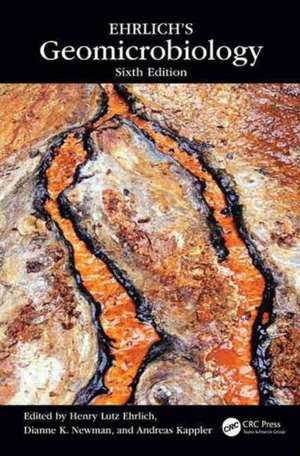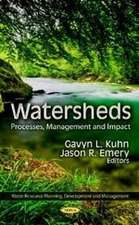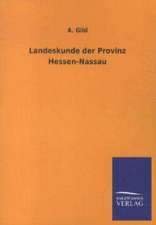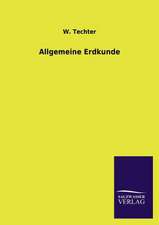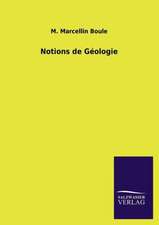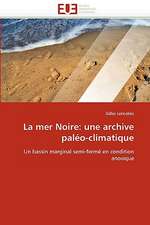Ehrlich's Geomicrobiology
Editat de Henry Lutz Ehrlich, Dianne K. Newman, Andreas Kappleren Limba Engleză Hardback – 15 oct 2015
The Sixth Edition Includes:
- Extensive revisions and updates to most chapters from the fifth edition
- A new chapter on terrestrial subsurface ecosystems
- A new chapter summarizing important principles of geomicrobiology
- New discussions and references on the latest findings and theories in geomicrobiology
| Toate formatele și edițiile | Preț | Express |
|---|---|---|
| Paperback (1) | 471.20 lei 6-8 săpt. | |
| CRC Press – 30 mar 2021 | 471.20 lei 6-8 săpt. | |
| Hardback (1) | 1356.19 lei 6-8 săpt. | |
| CRC Press – 15 oct 2015 | 1356.19 lei 6-8 săpt. |
Preț: 1356.19 lei
Preț vechi: 1653.89 lei
-18% Nou
Puncte Express: 2034
Preț estimativ în valută:
259.50€ • 271.67$ • 214.72£
259.50€ • 271.67$ • 214.72£
Carte tipărită la comandă
Livrare economică 05-19 aprilie
Preluare comenzi: 021 569.72.76
Specificații
ISBN-13: 9781466592407
ISBN-10: 1466592400
Pagini: 654
Ilustrații: 178 black & white illustrations, 26 black & white tables
Dimensiuni: 178 x 254 x 43 mm
Greutate: 1.29 kg
Ediția:Revizuită
Editura: CRC Press
Colecția CRC Press
ISBN-10: 1466592400
Pagini: 654
Ilustrații: 178 black & white illustrations, 26 black & white tables
Dimensiuni: 178 x 254 x 43 mm
Greutate: 1.29 kg
Ediția:Revizuită
Editura: CRC Press
Colecția CRC Press
Cuprins
Introduction. Earth as a Microbial Habitat. Emergence of Life and Its Early History. Uppermost Lithosphere as a Microbial Habitat. Terrestrial Subsurface Ecosystem. Hydrosphere as Microbial Habitat. Geomicrobial Processes: A Physiological and Biochemical Overview. Cultivation, In Situ Measurements, and Geochemical Techniques for Geomicrobiological Studies. Molecular Methods in Geomicrobiology. Microbial Formation and Degradation of Carbonates. Geomicrobial Interactions with Silicon. Geomicrobiology of Aluminum: Microbes and Bauxite. Geomicrobial Interactions with Phosphorus. Geomicrobiology of Nitrogen. Geomicrobial Interactions with Arsenic and Antimony. Geomicrobiology of Mercury. Geomicrobiology of Iron. Geomicrobiology of Manganese. Geomicrobial Interactions with Other Transition Metals (Chromium, Molybdenum, Vanadium, Technetium), Metalloids (Polonium), Actinides (Uranium, Neptunium, and Plutonium) and the Rare Earth Elements. Geomicrobiology of Sulfur. Biogenesis and Biodegradation of Sulfide Minerals in the Earth’s Surface. Geomicrobiology of Selenium and Tellurium. Geomicrobiology of Fossil Fuels.
Notă biografică
Henry Lutz Ehrlich, PhD, is an active retiree with the Rensselaer Polytechnic Institute, Troy, New York. He earned his PhD in agricultural microbiology with a minor in biochemistry from the University of Wisconsin, Madison. He is a fellow of the American Academy of Microbiology and the American Association for the Advancement of Science. His research efforts have centered on geomicrobiology since 1959, and he was the editor-in-chief of the Geomicrobiology Journal from 1983-1995 and has been the co-editor-in-chief since 1995.
Andreas Kappler, PhD, is professor of geomicrobiology at Eberhard Karls University of Tübingen, Germany. He received his PhD in environmental microbiology and microbial ecology at the University of Konstanz, Germany. He moved to Tübingen in 2004 to head an Emmy-Noether Junior Research Group in geomicrobiology before being appointed to his current professorship. His research focuses on the formation and transformation of iron (Fe) minerals by Fe (II)-oxidizing and Fe (III)-reducing bacteria, the implications of these processes for the fate of pollutants in soils and sediments, and the deposition of iron minerals on early Earth. His research combines microbial cultivation, molecular biology, fluorescence and electron microscopy, Mössbauer spectroscopy, synchrotron-based X-ray absorption spectroscopy, and spectromicroscopy.
Dianne K. Newman, PhD, earned her doctorate in environmental engineering with an emphasis on microbiology from the Massachusetts Institute of Technology in Cambridge. She gained training in bacterial genetics as a postgraduate scholar at Harvard Medical School. She is professor of biology and geobiology and an investigator of the Howard Hughes Medical Institute at the California Institute of Technology, Pasadena. She is a member of the American Society of Microbiology and the American Geophysical Union. Her research focuses on understanding the coevolution of anaerobic microbial metabolisms and environmental chemistry. The contexts that motivate her research span ancient sedimentary deposits to chronic infections. Her work is helping to reshape interpretations of ancient molecular fossils as well as redox-active "secondary" metabolites.
Andreas Kappler, PhD, is professor of geomicrobiology at Eberhard Karls University of Tübingen, Germany. He received his PhD in environmental microbiology and microbial ecology at the University of Konstanz, Germany. He moved to Tübingen in 2004 to head an Emmy-Noether Junior Research Group in geomicrobiology before being appointed to his current professorship. His research focuses on the formation and transformation of iron (Fe) minerals by Fe (II)-oxidizing and Fe (III)-reducing bacteria, the implications of these processes for the fate of pollutants in soils and sediments, and the deposition of iron minerals on early Earth. His research combines microbial cultivation, molecular biology, fluorescence and electron microscopy, Mössbauer spectroscopy, synchrotron-based X-ray absorption spectroscopy, and spectromicroscopy.
Dianne K. Newman, PhD, earned her doctorate in environmental engineering with an emphasis on microbiology from the Massachusetts Institute of Technology in Cambridge. She gained training in bacterial genetics as a postgraduate scholar at Harvard Medical School. She is professor of biology and geobiology and an investigator of the Howard Hughes Medical Institute at the California Institute of Technology, Pasadena. She is a member of the American Society of Microbiology and the American Geophysical Union. Her research focuses on understanding the coevolution of anaerobic microbial metabolisms and environmental chemistry. The contexts that motivate her research span ancient sedimentary deposits to chronic infections. Her work is helping to reshape interpretations of ancient molecular fossils as well as redox-active "secondary" metabolites.
Descriere
This new edition surveys various aspects of geomicrobiology, including the microbial role in elemental cycling and in the formation and degradation of minerals and fossil fuels. Unlike the previous edition, many expert contributors besides the editors have been included, providing added depth to topics and broadening the overall insights. The new breadth of scope and possible applications in agriculture, forestry, aquaculture, marine science, the metals industry, and more that this book presents make it a must-have source in geomicrobiology.
